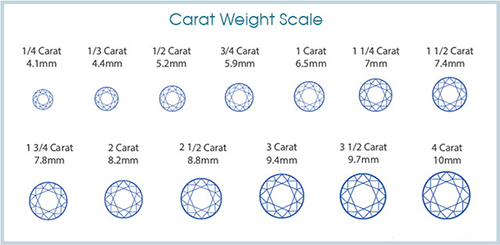Color
To grade color, modern Gemologists use colorimeters that take Direct Readings Digitally based on light absorption unaffected by hue or fluorescence. Traditional Gemologists grade color with master stones, (true stones graded and recorded at the Gemological Institute of America's gem trade lab). The example above illustrates color grading from colorless to yellow with corresponding Color grades.
No matter the brilliance, the color or the setting none can compare to the beauty of a diamond. A completely colorless diamond invites white light to pass through it and emerge as rainbows of color. A finer prism cannot be constructed. Truly one of natures wonders.
Cut
In its natural state, a diamond's beauty is generally concealed. While nature determines a diamond's color, clarity, and carat weight, the hand of a master craftsman is needed to release its fire and beauty. What draws out its brilliance is the cut of the diamond, which under ideal circumstances maximizes the optical properties within the diamond, particularly its ability to refract light and disperse color.
Not to be confused with the shape of a diamond, cut refers to the arrangement of a diamond's facets. A diamond that is "ideal cut" captures and releases the maximum play of light. The cut gives each diamond its unique sparkle and brilliance by allowing the maximum amount of light to enter and reflect back out of the diamond.
To achieve an ideal cut, the diamond cutter must adhere to a whole series of exacting tolerances. Those tolerances, in turn, may well mean that much of the rough diamond has to be cut away. For that reason, ideal cut diamonds are the exception rather than the rule. In fact, fewer than 1% of all diamonds are cut to ideal proportions. Consequently, you're likely to find ideal cut diamonds in only the finest stores.
If the cut is too deep or too shallow light will spill through the side or bottom and be lost, resulting in a less brilliant display and thus, a less valuable diamond. Cut is the most critical of all the variables that affect the value of a diamond. It is essential you know the quality of the cut when purchasing a diamond.
Round diamonds are symmetrical and capable of reflecting the most of the light, are the most brilliant of all the diamond shapes.
Fancy shaped diamonds are diamonds other than rounds have different proportion guidelines than the one shown above for round diamond, and affect the ability of the diamond to refract light in different ways. When light strikes a fancy shaped diamond, a small amount of light is lost through the bottom of the stone.
Clarity
Clarity is an indication of a diamond's purity. Clarity is determined by the number, size and location of inclusions, the diamond's naturally occurring internal characteristics. They may look like tiny crystals, clouds, or feathers and they're what make each diamond different and unique. Many of these birthmarks are not visible to the naked eye. The fewer and smaller the inclusions, the less they interfere with light as it passes through the diamond. Generally, the only way to see inclusions is with a binocular microscope.
The U.S. Federal Trade Commission has established the jewelry industry's standards for diamond clarity based on 10-power magnification. A diamond is graded by its relative departure from "flawless"--the complete absence of inclusions under 10x magnification.
Less than 1% of all diamonds ever found have had no inclusions and can be called flawless (FL) or internally flawless (IF). Obviously, then, the larger, more visible and frequently occurring the inclusions, the lower the grade and the less rare the diamond.
It should be noted that a well-cut diamond can minimize the appearance of inclusions. For that reason and many others, you should carefully select a jeweler who can competently evaluate both cut and clarity.
Carat-Weight
A carat is the universal measure of weight for a diamond. It's the easiest of the 4Cs to determine, but two diamonds of equal size can have very different values, because the quality is still determined by the color, clarity and cut. Larger diamonds are found relatively infrequently in nature, which puts them at the rarest level of the Diamond Quality Pyramid. For example, fewer than one percent of women will ever own a diamond weighing one or more carats.
Despite the ease of measuring weight and the relative insignificance of weight in determining the value of a diamond, there are some factors you should know about the relationship between diamond weight and price. As diamonds increase in size, their cost tends to increase geometrically rather than arithmetically. Thus, a one-carat diamond can cost significantly more than a one-half carat diamond of equal quality. On the other hand, when a diamond cut is not good, the additional weight may reduce its brilliance.
For these reasons, you are well-advised to consult a gemologist regarding the question of carat-weight, when it relates to the quality of the diamond's cut.









